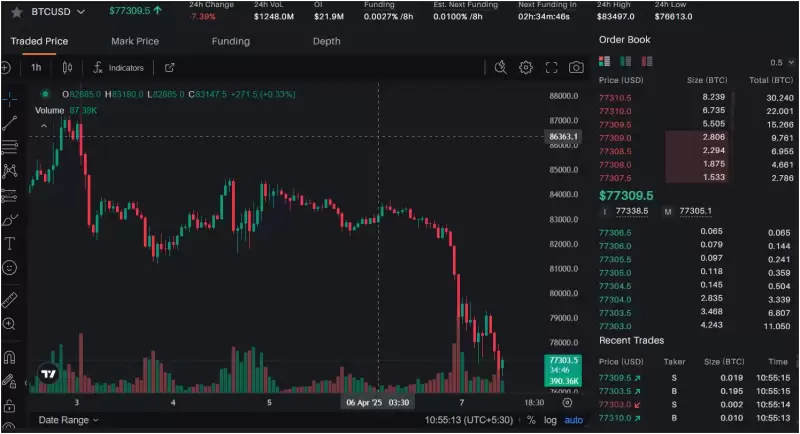 |
|
 |
|
 |
|
 |
|
 |
|
 |
|
 |
|
 |
|
 |
|
 |
|
 |
|
 |
|
 |
|
 |
|
 |
|
Cryptocurrency News Articles
The increasing presence of cryptocurrencies and stablecoins is prompting UK regulators to warn of possible dangers to the stability of the monetary system.
Apr 12, 2025 at 03:03 am
UK regulatory bodies are becoming increasingly uneasy about the effects stablecoins and the crypto industry may have on financial stability and monetary policy.

The increasing presence of cryptocurrencies and stablecoins is prompting UK regulators to warn of possible dangers to the stability of the monetary system.
As reported by the Financial Times, members of the Financial Policy Committee (FPC) at the Bank of England (BoE) are growing increasingly uneasy about the effects stablecoins and the broader crypto industry may have on financial stability and monetary policy.
At the FPC meetings on April 4 and 8, regulators pointed out that despite the growing interconnectedness of unbacked crypto markets with the economy, the rapid rise of stablecoins and crypto markets in the past year has intensified regulatory concern.
The UK, its central bank, and the Financial Conduct Authority have made developing stablecoin frameworks to enhance financial resilience a priority.
The committee believes it has established the factors that contribute to a stablecoin’s resilience.
“A key determinant of the resilience of stablecoins was the liquidity, credit and market risks of their backing assets, which were in place to ensure that redemptions can be met in a timely manner at par, even in periods of stress.”
The committee raised alarm over the “greater issuance of sterling offshore stablecoins with inappropriate backing assets.”
The committee pointed out that this has implications for UK financial markets, emphasizing that, “even with appropriate regulation, greater use of stablecoins denominated in foreign currencies could make some economies vulnerable to the currency substitution.”
Committee members are concerned that if stablecoin adoption grows beyond crypto settlements, it could affect cross-border payments in both retail and wholesale sectors.
Retail use of stablecoins by households and SMEs for cross-border payments could cause currency substitution, which would elevate counterparty risk.
This statement followed reports about the expanding use of stablecoins in emerging markets, with a focus on Africa, extending beyond just crypto remittances.
Stablecoins now make up close to half of all transaction volume in Sub-Saharan Africa, as per a recent report by Chainalysis.
In late 2024, a report noted that a number of African emerging markets have the potential to position themselves as digital asset hubs.
Yet, experts have not reported such trends in developed economies where financial infrastructure is readily available.
Experts attribute the adoption of dollar-backed stablecoins and cryptocurrencies in developing countries, especially in Africa, to the scarcity of banking services and the volatility of local currencies.
Alongside the UK, other nations are equally concerned about the potential impact of stablecoins and the broader cryptocurrency industry on monetary stability.
According to the European Securities and Markets Authority (ESMA), the growing influence of crypto and its integration with traditional finance will increasingly undermine the stability of financial markets. ESMA’s executive director, Natasha Cazenave, commented:
“We cannot rule out that future sharp drops in crypto prices could have knock-on effects on our financial system.”
Local regulators have already started taking actions to address these concerns.
To mitigate risks for policyholders, the European Union’s insurance regulator proposed in late March that insurance firms must maintain capital equivalent to their crypto holdings.
Recently, the European Central Bank has advocated for shielding Europe from the expanding hold of U.S. dollar-backed stablecoins.
Piero Cipollone, an ECB executive, highlighted the U.S.’s increasingly crypto-friendly stance and its push to broaden the global presence of dollar stablecoins, which he considers worrisome.
In response, Cipollone suggests that launching a digital euro could curb the influence of foreign currency stablecoins as a prevalent form of exchange in the eurozone.
Disclaimer:info@kdj.com
The information provided is not trading advice. kdj.com does not assume any responsibility for any investments made based on the information provided in this article. Cryptocurrencies are highly volatile and it is highly recommended that you invest with caution after thorough research!
If you believe that the content used on this website infringes your copyright, please contact us immediately (info@kdj.com) and we will delete it promptly.
-

-

- Arthur Cheong Warns of Growing Cryptocurrency Price Manipulation, Describing the Trend as a Serious Danger to Investor Trust
- Apr 15, 2025 at 03:15 pm
- Arthur Cheong, the founder of DeFiance Capital, has warned of growing cryptocurrency price manipulation, describing the trend as a serious danger to investor trust
-

-

- Bhutan's Prime Minister Backs Government Involvement in Bitcoin Mining, Citing Potential Billions in Returns
- Apr 15, 2025 at 03:10 pm
- During an interview with Al Jazeera, Tshering Tobgay revealed that the utilization of the country's excess hydropower energy during the summer months for Bitcoin mining made “tremendous sense.”
-

- AItonomy.world Officially Launches on BNB Chain, Igniting the AI Agent Creator Economy
- Apr 15, 2025 at 03:05 pm
- Verisense Network is pleased to announce that AItonomy is officially launched on BNB Chain, igniting the AI Agent creator economy and pioneering the concept of AigentFi - Agent is the token, and the token is the Agent.
-

-

-

- Trump Pauses Tariffs on Imports From China, Boosting Crypto and Stock Markets
- Apr 15, 2025 at 03:00 pm
- The crypto market got a strong boost recently after Donald Trump announced a 90-day pause on tariffs for imports from over 70 countries. This move brought some relief to investors and sparked a solid comeback in both crypto and stock markets.
-




























































